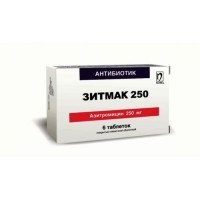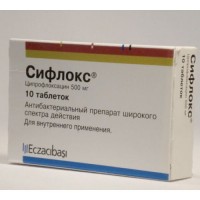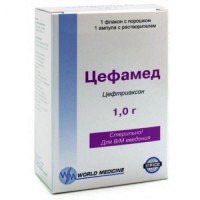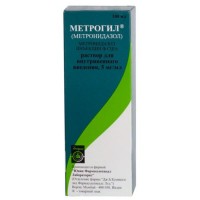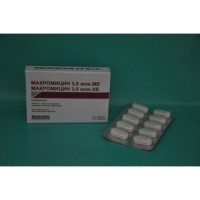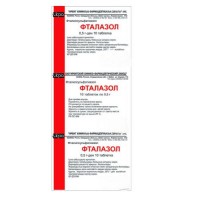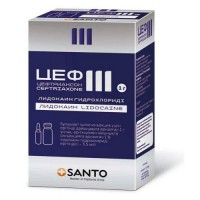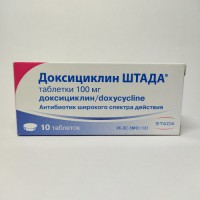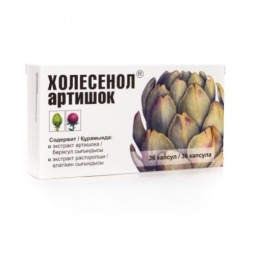OD-LeVox 5's 500 mg film-coated tablets
- $19.10
The instruction for medical use of medicine of AUDE-Levoks the Trade name of AUDE-Levoks Mejdounarodnoye the unlicensed name Levofloxacin Dosage Form of the Tablet, film coated, 500 mg Structure One tablet contains active agent - a levofloksatsin gemigidrat 512.47 mg (it is equivalent to a levofloksatsin of 500.00 mg), excipients: krospovidon, cellulose microcrystalline, hydroksipropilmetiltsellyuloza (5 cps), silicon dioxide colloidal, talc, magnesium stearate, structure of a cover: hydroksipropilmetiltsellyuloza (5 cps), polyethyleneglycol 6000, titan E171 dioxide, talc, methylparahydroxybenzoate, propilparagidroksibenzoat. The description of the Tablet of a capsulovidny form, film coated white or almost white color, with risky on one party. On cross section two layers are visible. On a break a kernel of a tablet of yellow color. Pharmacotherapeutic group Antibacterial drugs for system use. Antimicrobial drugs – derivatives of a hinolon. Ftorkhinolona. Levofloxacin the ATX J01MA12 Code the Pharmacological Pharmacokinetics At properties intake levofloxacin is quickly and almost completely soaked up (meal influences the speed and completeness of absorption a little). Bioavailability - 99%. Time of achievement of the maximum concentration (TCmax) in plasma – 1-2 h. At reception of 500 mg the maximum concentration (Cmax) in plasma makes 5.2 mkg/ml. Communication with proteins of plasma about 30-40%. Moderate cumulation of a levofloksatsin is observed for the third day of administration of drug in a dose of 500 mg 2 times a day. Well gets into bodies and fabrics: lungs, mucous membrane of bronchial tubes, phlegm, bodies of an urinogenital system, polymorphonuclear leukocytes, alveolar macrophages. Cmax in mucous bronchial tubes and liquid of an epithelial vystilka after oral administration of 500 mg of drug – 8.3 mkg/g and 10.8 mkg/ml respectively, Cmax of a levofloksatsin in liquid of blisters – 4.0-6.7 mkg/ml, TCmax in this case – 2-4 h Cmax in tissues of lungs after oral administration of 500 mg of drug – 11.3 mkg/g, and TCmax – 4-6 h. Levofloxacin in small quantities gets into cerebrospinal fluid. At oral administration of 500 mg/days of a levofloksatsin for the third day of treatment of Cmax in prostate fabrics in 2, 6 and 24 hours after administration of drug – 8.7 mkg/g, 8.2 mkg/g and 2.0 mkg/g respectively. The concentration relation prostate/plasma on average – 1.84. Average Cmax value in urine after reception of 500 mg of drug in 8-12 h – 200 mg/l. In a liver a small part of drug is oxidized and/or dezatsetilirutsya. Elimination half-life (T1/2) – 6-8 h. It is brought out of an organism mainly by kidneys (about 85% of the accepted dose) by glomerular filtration and canalicular secretion. 4% of the dose of a levofloksatsin accepted inside are removed by intestines during 72 h. In renal failures and reduction of renal clearance T1/2 increases. During clinical trials, differences in drug pharmacokinetics at men and women were not noted. A pharmacodynamics Levofloxacin – the antibiotic of a broad spectrum of activity from group of ftorkhinolon containing left-handed isomer of an ofloksatsin in quality of active agent. Blocks DNK-girazu (topoisomerase II) and topoisomerase IV, breaks superspiralling and a stitching of ruptures of DNA, suppresses DNA synthesis, causes profound morphological changes in cytoplasm, a cell wall and membranes. It is effective concerning the majority of strains of microorganisms as in the conditions of in vitro and in vivo. Are sensitive to effect of drug: - aerobic gram-positive microorganisms: Staphylococcus aureus (metitsillinchuvstvitelny strains), Staphylococcus saprophyticus, Streptococcus spp. groups C and G, Streptococcus agalactiae, Streptococcus pneumoniae (penitsillinchuvstvitelnye/moderately sensitive / resistant strains), Streptococcus pyogenes - aerobic gram-negative microorganisms: Burkholderia cepacia, Eikenella corrodens, Haemophilus influenzae (ampitsillinchuvstvitelnye/resistant strains), Haemophilus parainfluenzae, Klebsiella spp. (including Klebsiella oxytoca, Klebsiella pneumoniae), Moraxella catarrhalis (which are producing and not producing some beta lactamazu strains), Pasteurella multocida, Proteus vulgaris, Providencia rettgeri - anaerobic bacteria: Peptostreptococcus spp. - other microorganisms: Chlamydia pneumoniae, Chlamydia psittaci, Chlamydia trachomatis, Legionella pneumophila, Mycoplasma pneumoniae, Mycoplasma hominis, Ureaplasma urealyticum Microorganisms at which the acquired resistance - aerobic gram-positive microorganisms is possible: Enterococcus faecalis, Staphylococcus aureus (resistant to Methicillinum), Staphylococcus coagulase spp. - aerobic gram-negative microorganisms: Acinetobacter baumannii, Citrobacter freundii, Enterobacter aerogenes, Enterobacter agglomerans, Enterobacter cloacae, Escherichia coli, Morganella morganii, Proteus mirabilis, Providencia stuartii, Pseudomonas aeruginosa, Serratia marcescens - anaerobic microorganisms: Bacteroides fragilis, Bacteroides thetaiotaomicron, Bacteroides vulgatus, Bacteroides ovatus, Clostridium difficile In the hospital infections caused by Pseudomonas aeruginosa can be required combination therapy. Indications AUDE-Levoks Drug is used in the infectious and inflammatory diseases caused by microorganisms, sensitive to drug: - the lower airways (exacerbation of chronic bronchitis, community-acquired pneumonia) - ENT organs (acute bacterial sinusitis) - urinary tract and kidneys (including acute pyelonephritis) - chronic bacterial prostatitis - infections of skin and soft tissues (the festered atheromas, abscess, furuncles) the Route of administration and AUDE-Levoks doses it is necessary to apply inside one or twice a day, without chewing, washing down with enough liquid. The tablet can be halved (after risk on a tablet). Doses of drug of AUDE-Levoks are defined by character and weight of an infection and also sensitivity of the expected activator. The recommended drug dose for adults: In acute bacterial sinusitis – 500 mg of 1 times a day within 10-14 days, At exacerbation of chronic bronchitis – 250-500 mg of 1 times a day within 7 - 10 days, At community-acquired pneumonia – 500 mg 1 or 2 times a day within 7-14 days, In uncomplicated infections of urinary tract and kidneys – 250 mg (1/2 tablets) of 1 times a day within 3 days, At the complicated infections of urinary tract – 250 mg (1/2 tablets) of 1 times a day within 7-10 days, In chronic bacterial prostatitis – 500 mg of 1 times a day within 28 days, In infections of skin and soft tissues – 250-500 mg 1-2 times a day within 7-14 days, Special groups of patients the Dosage at disturbance of renal function (clearance of creatinine ≤ 50 ml/min.) the dosing Mode at normal function of kidneys, each 24 hours Clearance of creatinine, ml/min. 50 - 20 19 - 10 & lt, 10 (including a hemodialysis and DAPD *) 500 mg the first dose: 500 mg, then: To 250 mg there are each 24 hours the first dose: 500 mg, then: To 250 mg there are each 48 hours the first dose: 500 mg, then: 250 mg each 48 hours of 250 mg of correction of a dose are not required to 250 mg each 48 hours if it is not burdened by an infection of urinary tract, then correction of a dose is not required there Are no data on a possibility of correction of a dose 1 at a hemodialysis or the continuous out-patient peritoneal dialysis (COPPD) introduction additional is not required dosed In an abnormal liver function special selection of doses as levofloxacin only in insignificant degree is metabolized in a liver is not required and is removed mainly by kidneys. If administration of drug is missed it is necessary to take, as soon as possible, a pill, until the next reception. Further it is necessary to continue to accept levofloxacin on the recommended scheme. Side effects Frequent (& gt, 1/100, & lt, 1/10): - dizziness, a headache, insomnia - diarrhea, vomiting, nausea - increase in activity of hepatic enzymes in blood (for example, alaninaminotranspherases (AlAT), aspartate aminotransferases (AsAT), alkaline phosphotazy, scale of a glutamiltranspeptidaza (GGT) Infrequent (& gt, 1/1000, & lt, 1/100): - a leukopenia (reduction of quantity of leukocytes in peripheral blood), an eosinophilia (increase in quantity of eosinophils in peripheral blood) - the increased drowsiness, the general weakness (asthenia), irritability, vertigo - abdominal pain, dyspepsia, a meteorism, a constipation - increase in level of bilirubin and creatinine in blood serum - an itching, rash - anorexia - fungal infections, development of resistance of pathogenic microorganisms - an asthenia Rare (& gt, 1/10000, & lt, 1/1000): - urticaria - feeling of concern, confusion of consciousness - an asthma, a bronchospasm - heavy tachycardia, lowering of arterial pressure - a neutropenia (reduction of quantity of neutrophils in peripheral blood), thrombocytopenia (reduction of quantity of thrombocytes in peripheral blood) - attacks of spasms, paresthesia, a tremor, a psychotic state, a depression, confusion of consciousness, agitation, uneasiness - a ring in ears - damage of sinews, including a tendinitis, for example, an Achilles tendon, articulate and muscular pains - extrapyramidal symptoms and other disturbances of muscular coordination - diarrhea with impurity of blood which seldom or never is symptom of a coloenteritis, including pseudomembranous colitis Very rare (& lt, 1/10000) (including separate messages): - an acute renal failure, for example, owing to interstitial nephrite - a hypoglycemia (the coma is possible), especially at patients with diabetes (signs of a hypoglycemia: the wolf appetite, nervousness, a perspiration, a shiver) or a hyperglycemia (dryness in a mouth, thirst, the increased urination, fatigue, the obscured sight, dryness or an itching of skin, arrhythmia) - a Quincke's edema, an acute anaphylaxis, anaphylactic and anaphylactoid reactions can develop after reception of the first dose, the photosensitization, an allergic pneumonitis, fever - a disorder of vision and hearing - disturbance of flavoring sensitivity up to total loss of all flavoring feelings, disturbance of sense of smell up to its total loss - a rupture of sinews, for example, of an Achilles tendon - this side reaction can be observed within 48 hours after an initiation of treatment and has bilateral character, the muscle weakness which is of particular importance for patients with a heavy myasthenia - hepatitis - an agranulocytosis - mental reactions with autoaggressive behavior, including with suicide thoughts and actions, hallucinations - touch and sensomotor peripheral neuropathy Unknown frequency (it is not possible to determine occurrence frequency by the available data): - the toxic epidermal necrolysis, Stephens-Johnson's syndrome, a mnogoformny erythema, a hyperhidrosis - lengthening of an interval QT, an atrial flutter - a rhabdomyolysis - a pancytopenia, hemolytic anemia - hypersensitivity - jaundice, liver necrosis cases up to a life-threatening acute liver failure, first of all at patients with a serious basic disease is a dorsodynia, breasts and extremities - a hyper sensitive vasculitis - porphyria attacks at patients with a porphyria - benign intracranial hypertensia - temporary loss of sight of the Contraindication - hypersensitivity to a levofloksatsin or other ftorkhinolona and also to drug excipients - epilepsy - damage of sinews at treatment of a hinolonama in the anamnesis - pregnancy and the period of a lactation - children's and teenage age up to 18 years. Medicinal interactions of Hinolona can enhance ability of drugs, including theophylline, to lower a threshold of convulsive readiness. At at the same time reception with fenbufeny higher concentrations of a levofloksatsin are observed, than at monotherapy. Action of a levofloksatsin is reduced by the medicines (M) oppressing motility of intestines, sukralfat, magnesium - or aluminum-bearing antiacid means, salts of iron and zinc. Reception of glucocorticosteroids increases risk of a rupture of sinews. Levofloxacin enhances anticoagulating activity of warfarin. Removal (renal clearance) of a levofloksatsin slightly slows down under the influence of Cimetidinum and a probenetsid in view of possible blocking of kanaltsiyevy secretion of a levofloksatsin in kidneys. It should be noted that this interaction has clinical value, first of all, for patients with impaired renal function. Levofloxacin increases elimination half-life of cyclosporine. Simultaneous use of a levofloksatsin and hypoglycemic means (for example, glibenclamide, insulin) leads to change of concentration of glucose in blood plasma (hypoglycemia and a hyperglycemia). AUDE-Levoksom treatment in a combination with the antagonist of vitamin K (for example, with warfarin) can lead to increase in indicators of coagulative tests (the prothrombin time (PT) taking into account the international normalized relation (INR)) and/or to strengthening of bleeding, up to expressed. The patients receiving antagonists of vitamin K need to control regularly the level of a prothrombin and to carry out monitoring of the prothrombin time (PT) taking into account the international normalized relation (INR) which is defined as the relation of PV of the patient to control PV. With the medicines extending QT interval. Levofloxacin, as well as other ftorkhinolona, has to be applied with care at the patients receiving the drugs extending QT interval (for example, antiarrhythmic drugs of the class IA and III, tricyclic antidepressants, macroleads). Special instructions With care should be applied to elderly people (in connection with a high probability of existence of the accompanying depression of function of kidneys), at deficit glyukozo-6-fosfatdegidrogenazy. By AUDE-Levoks it has to be applied, at least, for 2 h to or 2 h after administration of drugs of salts of iron, zinc, antacids and the sukralfat. During drug treatment of AUDE-Levoks it is necessary to avoid solar and artificial UF-radiation in order to avoid damage of integuments (photosensitization). Appearance of a tendinitis is in rare instances possible, is more often than the Achilles tendon that can lead to its gap. Risk of developing a tendinitis and a rupture of a sinew is increased at advanced age and at the patients using corticosteroid drugs. Strict observation of such patients when prescribing of AUDE-Levoks drug with it is necessary. All patients at emergence of symptoms of a tendinitis need to see the attending physician. At suspicion of a tendinitis AUDE-Levoksom treatment it is necessary to stop and begin immediately the corresponding treatment of the affected sinew (for example, an immobilization). At emergence of signs of allergic reactions of AUDE-Levoks immediately cancel. It must be kept in mind that at patients with a brain damage in the anamnesis (a stroke, a severe injury) development of spasms is possible, and at insufficiency glyukozo-6-fosfatdegidrogenazy – risk of development of hemolysis. To AUDE-Levoks it is contraindicated to patients with epilepsy in the anamnesis. Besides, as well as in a case with other hinolona, it is necessary to observe the maximum care at drug treatment of AUDE-Levoks of the patients inclined to spasms (damage of the central nervous system), at simultaneous treatment fenbufeny and the similar non-steroidal anti-inflammatory drugs or drugs lowering a cerebral convulsive threshold (see the section Medicinal Interactions). In case of development of spasms AUDE-Levoksom treatment should be stopped. Diarrhea persistriruyushchy or with blood, arising against the background of or after AUDE-Levoksom therapy, can be a symptom of the disease connected with Clostridium difficile which severe form is pseudomembranous colitis. At suspicion of pseudomembranous colitis AUDE-Levoksom treatment needs to be stopped, to the patient immediately begin the supporting and specific therapy. At simultaneous use of drug of AUDE-Levoks and warfarin the careful monitoring of a prothrombin time and other indicators of blood clotting is necessary. Careful monitoring of concentration of glucose in blood plasma at simultaneous use of AUDE-Levoksa with hypoglycemic drugs is recommended (can develop hyper - or a hypoglycemia). Superinfection. As well as at use of other antibiotics, use of a levofloksatsin, especially for a long time, can lead to the strengthened reproduction of microorganisms, insensitive to it, that can cause changes of microflora (bacteria and mushrooms) which normal prinut
tvut at the person that can lead to development of superinfection. Therefore during treatment it is obligatory to carry out the repeated assessment of a condition of the patient and in case of development during treatment of superinfection it is necessary to take the appropriate measures. Lengthening of an interval of QT. It was reported about very exceptional cases of lengthening of an interval of QT at the patients receiving ftorkhinolona including levofloxacin. At use of ftorkhinolon, including levofloxacin, it is necessary to be careful at patients with the known risk factors of lengthening of an interval of QT: at patients of advanced age, at patients with not corrected electrolytic disturbances (with a hypopotassemia, a hypomagnesiemia), about a syndrome of inborn lengthening of an interval of QT, with heart diseases (heart failure, a myocardial infarction, bradycardia), at a concomitant use of the HP capable to extend an interval of QT, such as antiarrhytmic means of IA and the III class, tricyclic antidepressants, macroleads. Peripheral neuropathy. At the patients receiving ftorkhinolona, including levofloxacin, the touch and sensory-motor peripheral neuropathy which start can be quick was noted. If the patient has neuropathy symptoms, use of a levofloksatsin has to be stopped. It minimizes possible risk of development of irreversible changes. Aggravation of a pseudoparalytic myasthenia (myasthenia gravis). Levofloxacin should be applied with care at patients with a pseudoparalytic myasthenia (myasthenia gravis). Drugs of a levofloksatsin can cause serious, up to lethal outcomes, reaction of hypersensitivity, for example, a Quincke's disease, up to an acute anaphylaxis, sometimes after the first dose (see the section Side effects). The patients accepting AUDE-Levoks in case of development of reaction of hypersensitivity should see the attending physician or the emergency doctor immediately. At drug treatment of AUDE-Levoks the development of psychotic reactions is possible. In case of their development it is necessary to cancel administration of drug. It is recommended to be careful if it is necessary to appoint drug the patient with psychoses or with mental diseases in the anamnesis. Definition of opiates in urine at the patients accepting AUDE-Levoks can yield false positive result. Can be required to confirm the received result with other, more specific method. Liver necrosis cases, up to a life-threatening liver failure, were registered in connection with administration of drugs containing levofloxacin, in particular, at patients with a serious basic disease, for example, with sepsis (see. Side effects). It is necessary to stop drug treatment of AUDE-Levoks and to see the attending physician if there are signs and symptoms of a disease of a liver, such as anorexia, jaundice, coloring of urine in dark color, an itching and morbidity of a stomach. The feature of influence of medicine on ability to run motor transport and other difficult mechanical means during drug treatment of AUDE-Levoks needs to be careful at management of motor transport and occupation of other, potentially dangerous types of activity demanding the increased concentration of attention and speed of psychomotor reactions. Overdose Symptoms: confusion of consciousness, dizziness, disturbance of consciousness, a spasm, nausea, vomiting and erosive damages of mucous membranes is possible. When carrying out researches it was shown that at use of a levofloksatsin in the doses exceeding average and therapeutic the lengthening of an interval of QT is possible. Treatment: if necessary carry out symptomatic therapy, monitoring of the cardiogram. Levofloxacin is not removed at a hemodialysis, peritoneal dialysis and continuous peritoneal dialysis. There is no specific antidote. A form of release and packing On 5 tablets in blister strip packaging from aluminum foil and a film polyvinylchloride. On 1 or 2 planimetric pack together with the instruction for medical use in the state and Russian languages place in a pack cardboard. On 7 tablets in blister strip packaging from aluminum foil and a film polyvinylchloride. On 1 planimetric packing together with the instruction for medical use in the state and Russian languages place in a pack cardboard. To Store storage conditions in the dry, protected from light place at a temperature not above 30 °C. To store out of children's reach! 3 years not to apply a period of storage after an expiration date. Prescription status According to the prescription Ej Pharm Prayvet Limited Producer 166 Atlanta of Building, 209 Nariman Poynt, Mumbai – 400021, India
to Develop
tvut at the person that can lead to development of superinfection. Therefore during treatment it is obligatory to carry out the repeated assessment of a condition of the patient and in case of development during treatment of superinfection it is necessary to take the appropriate measures. Lengthening of an interval of QT. It was reported about very exceptional cases of lengthening of an interval of QT at the patients receiving ftorkhinolona including levofloxacin. At use of ftorkhinolon, including levofloxacin, it is necessary to be careful at patients with the known risk factors of lengthening of an interval of QT: at patients of advanced age, at patients with not corrected electrolytic disturbances (with a hypopotassemia, a hypomagnesiemia), about a syndrome of inborn lengthening of an interval of QT, with heart diseases (heart failure, a myocardial infarction, bradycardia), at a concomitant use of the HP capable to extend an interval of QT, such as antiarrhytmic means of IA and the III class, tricyclic antidepressants, macroleads. Peripheral neuropathy. At the patients receiving ftorkhinolona, including levofloxacin, the touch and sensory-motor peripheral neuropathy which start can be quick was noted. If the patient has neuropathy symptoms, use of a levofloksatsin has to be stopped. It minimizes possible risk of development of irreversible changes. Aggravation of a pseudoparalytic myasthenia (myasthenia gravis). Levofloxacin should be applied with care at patients with a pseudoparalytic myasthenia (myasthenia gravis). Drugs of a levofloksatsin can cause serious, up to lethal outcomes, reaction of hypersensitivity, for example, a Quincke's disease, up to an acute anaphylaxis, sometimes after the first dose (see the section Side effects). The patients accepting AUDE-Levoks in case of development of reaction of hypersensitivity should see the attending physician or the emergency doctor immediately. At drug treatment of AUDE-Levoks the development of psychotic reactions is possible. In case of their development it is necessary to cancel administration of drug. It is recommended to be careful if it is necessary to appoint drug the patient with psychoses or with mental diseases in the anamnesis. Definition of opiates in urine at the patients accepting AUDE-Levoks can yield false positive result. Can be required to confirm the received result with other, more specific method. Liver necrosis cases, up to a life-threatening liver failure, were registered in connection with administration of drugs containing levofloxacin, in particular, at patients with a serious basic disease, for example, with sepsis (see. Side effects). It is necessary to stop drug treatment of AUDE-Levoks and to see the attending physician if there are signs and symptoms of a disease of a liver, such as anorexia, jaundice, coloring of urine in dark color, an itching and morbidity of a stomach. The feature of influence of medicine on ability to run motor transport and other difficult mechanical means during drug treatment of AUDE-Levoks needs to be careful at management of motor transport and occupation of other, potentially dangerous types of activity demanding the increased concentration of attention and speed of psychomotor reactions. Overdose Symptoms: confusion of consciousness, dizziness, disturbance of consciousness, a spasm, nausea, vomiting and erosive damages of mucous membranes is possible. When carrying out researches it was shown that at use of a levofloksatsin in the doses exceeding average and therapeutic the lengthening of an interval of QT is possible. Treatment: if necessary carry out symptomatic therapy, monitoring of the cardiogram. Levofloxacin is not removed at a hemodialysis, peritoneal dialysis and continuous peritoneal dialysis. There is no specific antidote. A form of release and packing On 5 tablets in blister strip packaging from aluminum foil and a film polyvinylchloride. On 1 or 2 planimetric pack together with the instruction for medical use in the state and Russian languages place in a pack cardboard. On 7 tablets in blister strip packaging from aluminum foil and a film polyvinylchloride. On 1 planimetric packing together with the instruction for medical use in the state and Russian languages place in a pack cardboard. To Store storage conditions in the dry, protected from light place at a temperature not above 30 °C. To store out of children's reach! 3 years not to apply a period of storage after an expiration date. Prescription status According to the prescription Ej Pharm Prayvet Limited Producer 166 Atlanta of Building, 209 Nariman Poynt, Mumbai – 400021, India
to Develop

